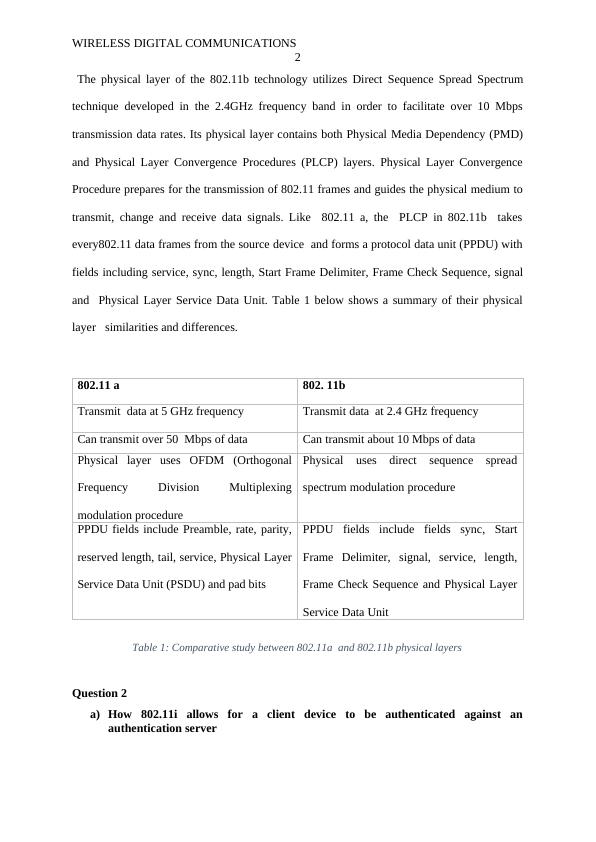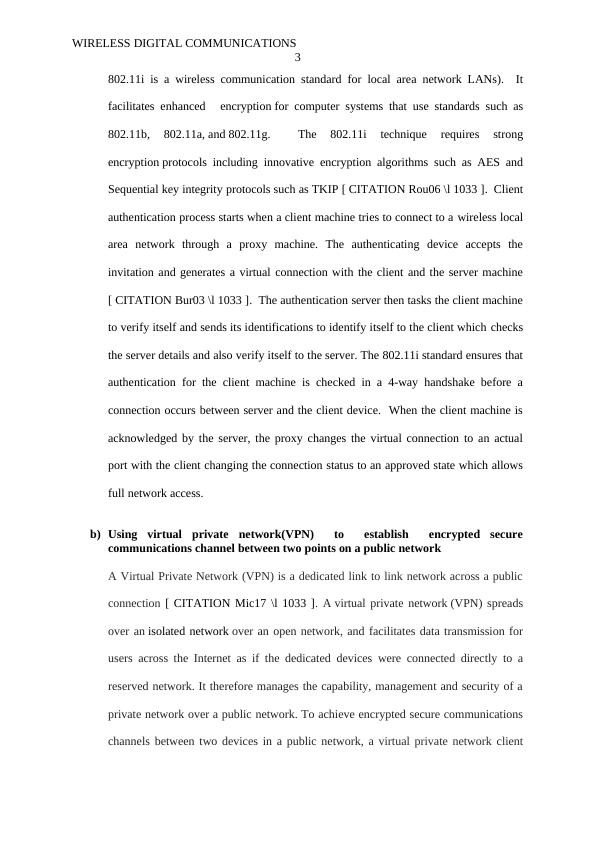Ask a question from expert
Wireless Digital Communications Assignment
9 Pages1877 Words266 Views
Added on 2019-10-30
Wireless Digital Communications Assignment
Added on 2019-10-30
BookmarkShareRelated Documents
Running head: WIRELESS DIGITAL COMMUNICATIONS 1Question 1The 802.11 standard 802.11refers to a wireless technology specification created by Institute of Electrical andElectronics Engineers (IEEE) involving two network layers including media access controland physical layer. 802.11 is used for executingwireless communication networks in thefrequency bands including 900MHz, 2.4,3.6, 5, and60GHz[ CITATION IEE17 \l 1033 ].Some of the most widely used 802.11 standards include 802.11b and 802.11a. Below is acomparison of their physical layers.Comparison and contrast of physical layers for 802.11b and 802.11a standardsi)The 802.11 a physical Layer The physical layer of 802.11a identifies the receiving and transmission frames belonging tothis standard. The 802.11a technology physical layer usesOrthogonal Frequency DivisionMultiplexing (OFDM) technique to be able to sustain and maintain the operation ofapproximately 50Mbps data transfer rates in 5GHz frequency band. The 802.11a physicallayer uses convergence procedure (PLCP) to transform 802.11 frames to be broadcasted intoa protocol data unit (PPDU) which has several fields such as PLCP preamble, rate, parity,reserved length, tail, service, physical layer service data unit (PSDU) and pad bits. OFDMdistributes data signals transversely into 48 different channels inside a 20MHz channel tooffer broadcasts of between 6Mbps to 54Mbps. Under transmission, the 802.11a decodes datasignals into analog formats with frequencies equivalent to channels selected by users.ii)The 802.11b physical Layer

WIRELESS DIGITAL COMMUNICATIONS 2 The physical layer of the 802.11b technology utilizes Direct Sequence Spread Spectrumtechnique developed in the 2.4GHz frequency band in order to facilitate over 10 Mbpstransmission data rates. Its physical layer contains both Physical Media Dependency (PMD)and Physical Layer Convergence Procedures (PLCP) layers. Physical Layer ConvergenceProcedure prepares for the transmission of 802.11 frames and guides the physical medium totransmit, change and receive data signals. Like 802.11 a, the PLCP in 802.11b takesevery802.11 data frames from the source device and forms a protocol data unit (PPDU) withfields including service, sync, length, Start Frame Delimiter, Frame Check Sequence, signaland Physical Layer Service Data Unit. Table 1 below shows a summary of their physicallayer similarities and differences. 802.11 a802. 11bTransmit data at 5 GHz frequency Transmit data at 2.4 GHz frequencyCan transmit over 50 Mbps of data Can transmit about 10 Mbpsof data Physical layer uses OFDM (OrthogonalFrequency Division Multiplexingmodulation procedure Physical uses direct sequence spreadspectrum modulation procedurePPDU fields include Preamble, rate, parity,reserved length, tail, service, Physical LayerService Data Unit (PSDU) and pad bitsPPDU fields include fields sync, StartFrame Delimiter, signal, service, length,Frame Check Sequence and Physical LayerService Data UnitTable 1: Comparative study between 802.11a and 802.11b physical layersQuestion 2a)How 802.11i allows for a client device to be authenticated against anauthentication server

WIRELESS DIGITAL COMMUNICATIONS 3802.11i is a wireless communication standard for local area network LANs). Itfacilitates enhanced encryptionfor computer systems that use standards such as802.11b, 802.11a,and802.11g. The 802.11i technique requires strongencryptionprotocols including innovative encryption algorithms such as AES andSequential key integrity protocols such as TKIP [ CITATION Rou06 \l 1033 ]. Clientauthentication process starts when a client machine tries to connect to a wireless localarea network through a proxy machine. The authenticating device accepts theinvitation and generates a virtual connection with the client and the server machine[ CITATION Bur03 \l 1033 ]. The authentication server then tasks the client machineto verify itself and sends its identifications to identify itself to the client which checksthe server details and also verify itself to the server. The 802.11i standard ensures thatauthentication for the client machine is checked in a 4-way handshake before aconnection occurs between server and the client device. When the client machine isacknowledged by the server, the proxy changes the virtual connection to an actualport with the client changing the connection status to an approved state which allowsfull network access. b)Using virtual private network(VPN) to establish encrypted securecommunications channel between two points on a public networkA Virtual Private Network (VPN) is a dedicated link to link network across a publicconnection [ CITATION Mic17 \l 1033 ]. Avirtual private network(VPN) spreadsover anisolated networkover an open network, and facilitates data transmission forusers across the Internet as if the dedicated devices were connected directly to areserved network. It therefore manages the capability, management and security of aprivate network over a public network. To achieve encrypted secure communicationschannels between two devices in a public network, a virtual private network client

End of preview
Want to access all the pages? Upload your documents or become a member.
Related Documents
Inner Workings of the Physical Layer of IEEElg...
|11
|2500
|82
Wireless Connectivity- Assignmentlg...
|9
|2154
|31
The Operational Range of Frequencylg...
|8
|1886
|54
Networking Assignment | Wireless Sensor Networklg...
|13
|2886
|64
Wireless Networks Assignmentlg...
|12
|2732
|95
Outlines a Wireless Local Area Networklg...
|9
|2033
|187